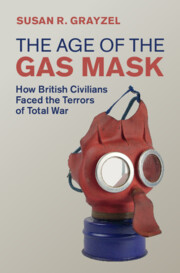Book contents
- The Age of the Gas Mask
- Studies in the Social and Cultural History of Modern Warfare
- The Age of the Gas Mask
- Copyright page
- Dedication
- Contents
- Figures
- Acknowledgments
- Abbreviations
- 1 Introduction
- 2 Inventing an Object for Modern Conflict
- 3 Defending Civilians
- 4 Unveiling the Gas Mask
- 5 Curating the Good Citizen
- 6 Facing Wartime
- 7 Conclusion
- Epilogue
- Notes
- Bibliography
- Index
5 - Curating the Good Citizen
The Gas Mask Goes to War, 1939–1941
Published online by Cambridge University Press: 21 July 2022
- The Age of the Gas Mask
- Studies in the Social and Cultural History of Modern Warfare
- The Age of the Gas Mask
- Copyright page
- Dedication
- Contents
- Figures
- Acknowledgments
- Abbreviations
- 1 Introduction
- 2 Inventing an Object for Modern Conflict
- 3 Defending Civilians
- 4 Unveiling the Gas Mask
- 5 Curating the Good Citizen
- 6 Facing Wartime
- 7 Conclusion
- Epilogue
- Notes
- Bibliography
- Index
Summary
The trial run of civil defence and the gas mask in September 1938 yielded several important lessons for the government. One was that it urgently needed to solve the absence of anti-gas protection for infants and toddlers, which it did by the time Britain entered the Second World War in September 1939. Until the outbreak of war, it continued to encounter resistance to these measures, and when war broke out, some conscientious objectors used their refusal to accept their gas masks as a sign of their commitment to oppose all war. As for the majority who accepted the mask as the gift of a benevolent state, the issue became whether or not they would follow instructions to carry them whenever they left their homes. The government soon came to see gas mask carrying not only as a mark of good morale, but also as indicating whether or not someone was being a good wartime citizen, willing to follow instructions in order to keep the entire civilian population safe. Mass Observation delegated respondents to survey who carried their masks, and they recorded these efforts as mapping onto attitudes towards the war effort. When the worst of the Battle of Britain had subsided with a decrease in devastating aerial attacks by April 1941, the government launched a concerted campaign, using posters, film, and staged gas mask drills to encourage the population to remember that “Hitler Will Give No Warning,” so everyone had to accept the obligation always to have a gas mask at the ready. Carrying and caring for the gas mask became a sign that you accepted your duty to participate in the war effort.
Keywords
- Type
- Chapter
- Information
- The Age of the Gas MaskHow British Civilians Faced the Terrors of Total War, pp. 128 - 173Publisher: Cambridge University PressPrint publication year: 2022

